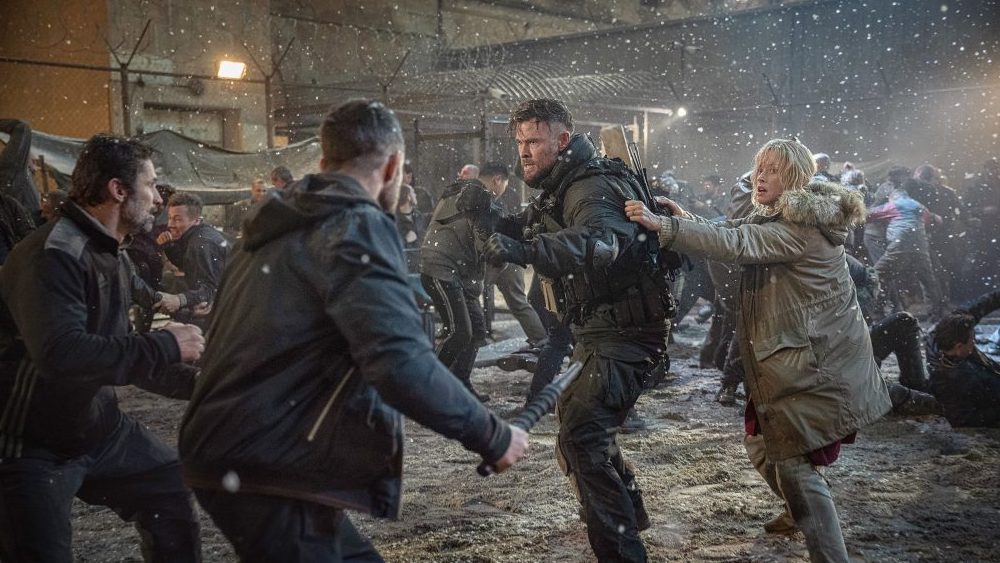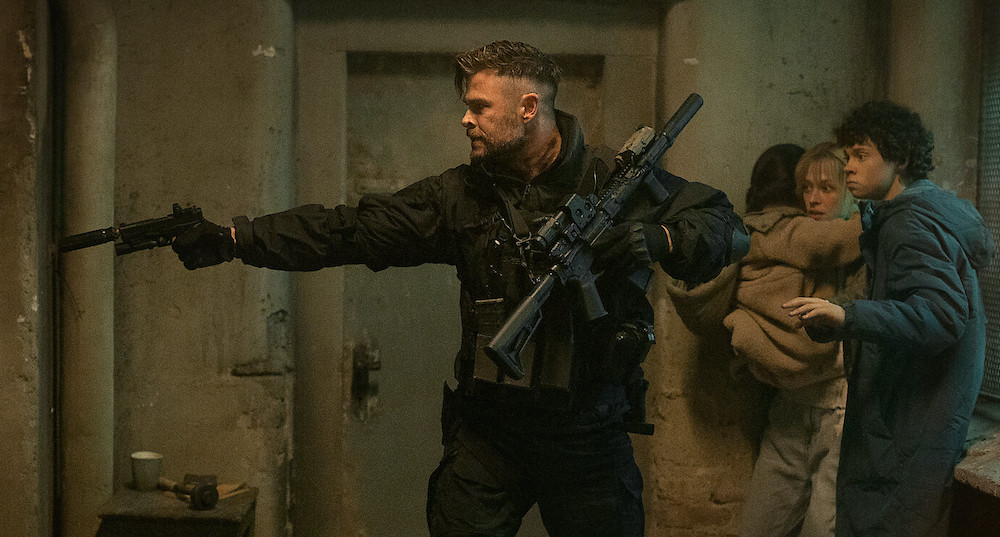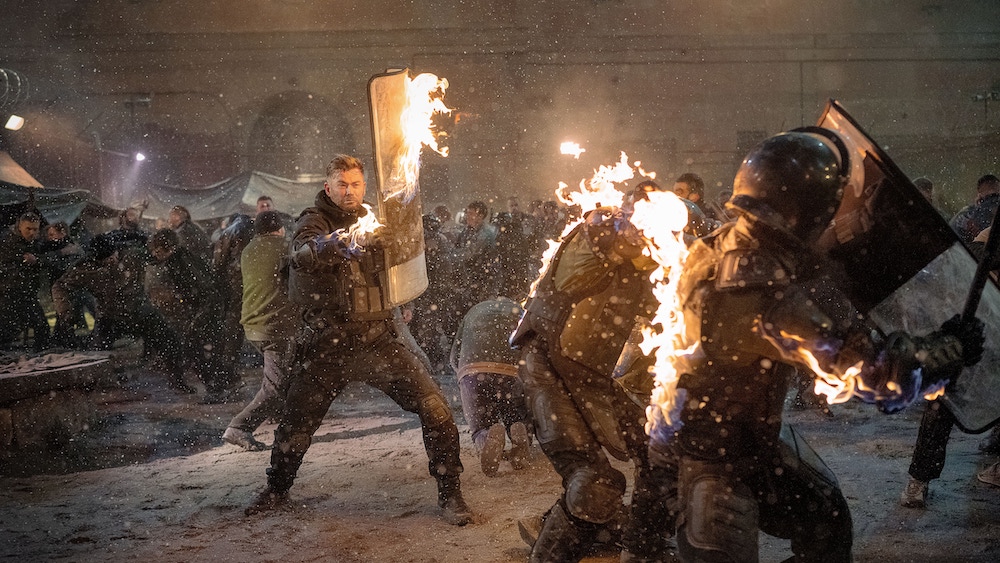
There are 21 minutes of pure action movie bliss in Extraction 2. In stuntman-turned-director Sam Hargrave‘s sequel to the original hit Netflix film, mercenary Tyler Rake (played by Chris Hemsworth) and his team break into a prison to pull off a rescue mission, fight off a riot, and then undergo both a car and train chase.
Bullets, limbs on fire, helicopters down, and more — all accomplished in a 21-minute-long single take.
Technically, it’s 21 minutes and sevens seconds, which features 49 hidden cuts and, at one point, 400 extras. It’s a thrilling set-piece and a simple case of sometimes bigger is better, at least in the hands of Hargave and his production team.
Recently, the filmmaker behind the Extraction series took us behind-the-scenes of pulling off the oner, which has more in common with Family Guy than the average Netflix subscriber might think.
[Note: This interview has been edited for clarity and length]
Below-the-Line: Your collaborator, Alex Rodriguez, edited one of the greatest long takes of all time [in Children of Men]. Did you talk to him before shooting about how to pull off a oner of this scale?
Hargrave: We were super fortunate to have one of the great editors of our era. Alex Rodriguez and Children of Men inspired the one-shot for the first movie and definitely for the second one. Now, Alex was on set with us the whole time we were shooting, since we had to stitch multiple different shots together in order to get this 21-minute long take. You can’t move on to the next sequence or next shot until the one before and the beginning of that shot match, so you can blend them together seamlessly.
Alex was definitely there giving his expertise and, you know, he was gonna have to deal with it and me for the next 10 months. Editors, the DP, and the visual effects supervisors, that was kind of the brain trust for these stitches. We wanted to try to make them work on the backend as little as possible by taking care of those stitches on the front end.
BTL: What were moments when Alex made clear a choice would or would not work?
Hargrave: He rarely said, “That won’t work.” He would say, “The body position of these guys could be a little better.” There are a lot of times [when] you’re trying to match exactly performers’ actions on the front and backside, to hide a stitch somewhere that it’s least expected. You know, we’d use some of the cliché ones on a whip pan or you’d go something foreground or off a wall, just because we had so many different stitches we wanted to mix it up.
But some stitches tried to put in kind of random places where you wouldn’t expect it. Most of the time it was getting very specific and going slowly, you know, back and forth and overlaying a moment where the body position was off and we had to try to do it again to line that up. Or we would talk to the visual effects [team] and say, “Is this something? So many other elements of that take were great. Can we use a digital double? Can we shift that? Can we just get a plate of this person and add part of him here or there?” Too numerous examples to list, but there were many times with a body position where it’d be, like, “We should do that again because that’s not working.”

BTL: Especially in the prison, did you find it easier to hide the stitches with the massive amount of extras?
Hargrave: No. Actually, it was the opposite, because there were so many layers that had to be the same. The less that’s in the frame, the easier the stitch because the fewer things you have to match. The easiest version is you let someone out of frame and you’re a little late to follow them, so it’s off a blank wall.
When you have Chris Hemsworth in the foreground, and then behind him, you’ve got the layer of stunt performers fighting…. Beyond that, you’ve got special skills extras, and beyond that, you have a background in between. You have snow and lights. There are so many elements in these shots. Those stitches were extremely difficult to match and recreate.
BTL: To your eyes and that of your team, what stitches wouldn’t work or didn’t look convincing?
Hargrave: A great example of this is when we landed the helicopter on a moving train. We did that five times. By the time we got to where we all thought we nailed it, we moved on and [did] take number five. We were all so excited about how it was stitched together. It was perfect. It’s amazing. When we got into post, it was too good, meaning it was so smooth and the camera hit everything right. It was so perfectly framed that it looked fake. We were like, “Ah, I love that take, but in take three, there’s a raw energy.”
BTL: By the way, you really build to the oner and action in general. You take your time in the first act building toward it. Was that always the plan?
Hargrave: That was something else that we found in post. Alex and Bill Hoy, our two editors, and other editors that came in, would all give advice and help with little sequences. It was a huge collaborative effort. We had a lot of great minds on this movie. Actually, the story was written in a different structure. It started with the oner and then you flashback to Tyler being discovered [after the first movie]. It read great. We all loved it.
What we found was what we were missing was this build to an explanation of who these people were, and why we cared. Because the oner was so long, we’re on this journey immediately with these people that we don’t quite know and we’re not quite sure why we’re on this journey. Without the stakes being explained, the emotion is lessened greatly. By moving it into a more linear fashion, we discovered that it was much more emotionally impactful when we started the action.
BTL: That would’ve been a helluva way to throw the audience into the deep end. How’d you also not want to lose the audience from exhaustion?
Hargrave: Are you a fan of Family Guy? There’s a classic bit where Peter bangs his knee on the mailbox, whatever, and he falls down, he just starts gasping. He keeps going. At first, it’s hilarious. And then he keeps going and you stop laughing and you go, “Wow, that’s not funny anymore. We get the joke, move on.” It keeps going and starts becoming funny again because of the absurdity of it. Now, that’s what it felt like with the oner. You’re like, “This is insane. They’re still going… Okay, all right guys, we get it. You’re doing a long car chase. Cool. Nice. Oh, you crashed the car. Okay, now they’re running to a train….” And so, the pacing was a big swing, but it felt right once we got there.
BTL: Did you ever have a moment on set with [cinematographer] Greg [Baldy] where you said, “Think of the pace like Family Guy?”
Hargrave: Yes. The sequence was 30 pages of a 90-page script. We knew it was gonna be a lot for an audience to digest. We needed the character moments, and that’s why it became imperative that we opened with these story points of how Tyler recovered and who these people were so that you could go along for this journey emotionally and not get action overload.

BTL: [Production Designer] Philip Ivey’s work on the prison is terrific. Was that a blend of a real location and set?
Hargrave: All credit to Phil for designing this thing ’cause we actually were meant to shoot this movie in Australia first. We had sets built, and we were 90% of the way there ready to shoot. And then the COVID spike hit Sydney. After that, we had 12 weeks to find locations and build sets. It was this mad rush once we got to Prague to get it done.
Phil and his team did an incredible job putting that together ‘cause it’s so visceral. The prison ended up being all practical locations, except for one scene. The actual stunt stuff was all located between two different locations. One was an actual prison and the other was, I think, a bread storage facility or a factory during World War II.
BTL: What were the top physical and safety challenges involved in pulling off the prison sequence?
Hargrave: Physically, the biggest challenge was the sheer number of people that we needed to fill the space. We didn’t wanna do it with digital characters, because it takes a little more time to shoot plates and crowds and then multiply them. It’s expensive. We spent a lot of time finding the right stunt performers to surround Chris.
We had different layers, like the special skills extras, all of whom had to learn a bunch of different fight choreography for different moments. Once we would cut, we’d basically shout, “Freeze! Remember where you are now because when we do this again or move on to the next thing, you have to start almost in the exact same place as before.” Coordinating all of those bodies in that prison was a massive undertaking.
Now, the most physically dangerous portion of the prison escape, like in the hand-to-hand combat, was lighting Chris Hemsworth on fire.
BTL: It looks great.
Hargrave: Four other stunt performers were on fire that night, and it was probably seven or eight times to get the shot. There were a few times where we used CG to enhance a flame because, by the time we got to the end, the fire was a bit less strong. Chris, he was on fire all night. You know, fire burns, so it’s all about the prep. So having the team that knows what’s going on and has all the safety precautions ready, they’re on the set, but also leading up to that they’ve prepped his clothes and prepared him what to do just in case.
BTL: Did your VFX supervisor ever say, “Hey, here’s how our work will blend best with these practical effects”?
Hargrave: For sure. With the Extraction franchise, we try to do as much as we can practically because audiences can tell the difference. The more you do practically, it allows you to sneak in that little CG shot and people don’t contemplate it too much or they go with it because so much has been real. They accept it more.
The fire is very difficult and we discussed it and it was like, “Yeah, it’s gonna be a lot less expensive and it’s gonna look a lot better if we can do it practically.” We had to, of course, ask Mr. Hemsworth. He was great. Not only is he one of the top actors of our day in physical specimens, but his commitment to the craft and willingness to put himself in harm’s way for the thrill of the audience is probably paralleled only by a few.

BTL: How’d Rebecca [Jónsdóttir] and Jennifer [Lander] decide on Tyler Rake’s costume for that mission?
Hargrave: We spoke extensively about realism. What would an operator wear in the cold at night? But also, how do we pick him out from the crowd, right? It’s always difficult when you dress your hero all in black, but it’s also what’s logical. He needs the bulky look, too, because it’s supposed to be winter in Georgia. Also, we were shooting in Prague where it was cold with wind and snow. So, Chris had to be dressed for the part but also be dressed for the part, so to speak, that he is not gonna freeze out there.
They did an amazing job giving us a lot of options to choose from. We’d try them all on, we’d take photos, we’d do like a camera test and we went with what not only looked great and practical but what he could move well in and what felt comfortable to him for doing all the stunts.
BTL: It’s such a visceral visual experience, but what did you and the sound team want for the audio?
Hargrave: Immersion. On the set, it’s tough ’cause you’re recording a lot of things happening. The camera’s moving so much and you can’t just plant microphone stands, right? It’s a foreign thing to have a boom mic there. So, the boom operator had to dance with the camera. If you turned the camera around on the crew, it was almost as entertaining as watching what was in front of the camera, because you had such an elaborate dance.
You had the operator, you had the focus puller, you had a guy in there with an eye-light and the boom op, and they’re all dancing in and around these hundreds of background people trying not to trip and fall, trying not to get in the shot. Sometimes they’d get caught up, and you’d get a great shot, but you’d look over and see the boom op, just like wide-eyed in the shot. Then we get to decide, do we paint him out? Do we go again?
When you got into the mixing stage, that whole team really went for it. They went over to that part of the world around and went to a prison. They recorded a bunch of Georgian actors yelling and screaming and running and fighting and moving. They’d go get all of the cars and bikes and guns. They would specifically record the exact gunshot. They did all that, so when you move in that [prison] environment, everything had a character to it. For each gun, we tried to give a specific sound and character.
BTL: You did a 12-minute oner in the first movie. The sequel is 21 minutes. For Extraction 3, where do you go from here?
Hargrave: Oh my gosh, what do you do? Well, if you’re being mathematical, the first one was 11:47. And then this one’s 21 minutes and seven-seconds. Now, you’re looking at a 40-minute oner potentially in the third movie, which is almost half of your movie. We’re gonna have to think long and hard about that one and to see if it can become too much of a good thing where you just have to subvert expectations and go a totally different direction or it’s become so much of a thing that you’re obligated to go bigger and better.
Extraction 2 is now available to stream on Netflix.





